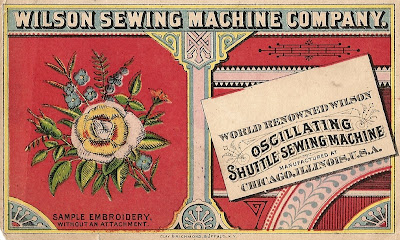I found two different dates for the start-up of the Wilson Sewing Machine Co. The company was founded in either 1867 or 1871 by W. G. Wilson. Originally operating in Cleveland, Ohio, the company moved to Chicago in 1875. The company was out of business by 1885.
Although $45 sounds like a great price for a sewing machine, at that time it was a pretty hefty price tag. One thing that led to the success of home sewing machines was the installment payment plan. A new idea at the time (and originated by the Singer Sewing Machine Co.), folks could purchase a sewing machine and pay it off a few dollars at a time. Another method that helped many families have the use of a sewing machine was a group purchase. Families would go together to purchase a machine, then take turns sharing it to make clothes for the family.
Once upon a time I had a Wilson sewing machine in my collection. Although in need of restoration, it was in decent shape and came with some great ephemera in the drawers. The ephemera included a Wilson Sewing Machine Co. brochure illustrating all their available models. Also included was a payment booklet showing the owner's payments on the machine; based on the payment schedule, it appeared the machine was purchased in 1876! One of the features I especially liked about this machine was the foot-shaped treadle pedal.
From the Wilson brochure: an illustration of what the original machine looked like. For those with a fancy for such things, extra silver plating could be purchased for just $10 more!
Here's a card that may make you wonder about truth in advertising. Illustrating embroidery work done on a Wilson machine, modern readers might be skeptical that such embroidery could be done on a simple, straight-stitch machine. Surprise! Intricate embroidery work was possible with straight stitch sewing machines and sewing machine companies used this as a selling point. The Singer Co. eventually gathered a number of these embroidery techniques into a book titled Singer Instructions for Art Embroidery and Lace Work. I have not personally tried any of these techniques, but I have no doubt wonderful results are possible. Note that this card advertises machines made in Chicago, so dates to post-1875.
Instructions for a happy home - another common trade card advertising ploy.
The reverse of the "young husband" card has a nice line drawing of a Wilson machine illustrating the foot pedal. Also, another price guide - note that machines may be bought on installment.
Although this card does not illustrate a sewing machine, it's dear to my heart! It was gifted to me by another sewing machine collector because it references a Wilson sewing machine dealer on Canal St. in New Orleans. I have searched the online databases available from the New Orleans Public Library, but have not been able to find additional info about the store. Some day I will do a search in person and see what I can discover about this sewing machine dealer.







